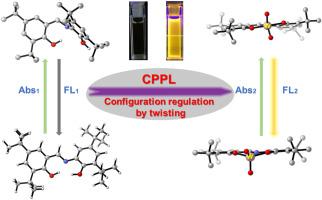Our official English website, www.x-mol.net, welcomes your
feedback! (Note: you will need to create a separate account there.)
Coordination-Promoted Photoluminescence Induced by Configuration Twisting Regulation
Journal of Luminescence ( IF 3.3 ) Pub Date : 2021-03-01 , DOI: 10.1016/j.jlumin.2020.117783 Yanan Wang , Yurong Guo , Yue Liang , Yu Pan , Yanan Shi , Ye Wang , Song Zhang , Bing Jin , Guangjiu Zhao
Journal of Luminescence ( IF 3.3 ) Pub Date : 2021-03-01 , DOI: 10.1016/j.jlumin.2020.117783 Yanan Wang , Yurong Guo , Yue Liang , Yu Pan , Yanan Shi , Ye Wang , Song Zhang , Bing Jin , Guangjiu Zhao

|
ABSTRACT In this work, we reported a coordination-promoted photoluminescence (CPPL) phenomenon of a new organometallic complex tBu(ONO)-W formed by ligand tBu(ONO) and metal tungsten for the first time. At the same time, the photoluminescence mechanisms of both the ligand tBu(ONO) and organometallic complex tBu(ONO)-W were investigated by using the steady-state and time-resolved spectroscopies as well as the time-dependent density functional theory (TDDFT) method. It was demonstrated that the weak photoluminescence of ligand tBu(ONO) could be ascribed as the destroyed planarity after significant configuration twisting in the excited state. However, the formation of the coordination bond between tBu(ONO) and the metal tungsten in the complex changes the two twisted parts of tBu(ONO) into a nearly planar configuration. The excited state configuration has a slight configuration change while the coplanarity of tBu(ONO)-W has not been destroyed. Therefore, the photoluminescence of tBu(ONO)-W is significantly enhanced compared to the ligand tBu(ONO). It can be proved that the coordination effect between the ligand and the metal inhibits the configuration twisting of tBu(ONO) and then promotes light emission. Moreover, it was also found that the emission peaks of tBu(ONO)-W are mainly originated from the relaxation of the ILCT and LMCT states. The experimental and theoretical results clearly show that the regulation of metal-ligand coordination bonds on the photoluminescence performance provides a new strategy for designing new high-performance luminescent materials.
中文翻译:

构型扭曲调控引起的配位促进光致发光
摘要 在这项工作中,我们首次报道了由配体 tBu(ONO) 和金属钨形成的新型有机金属配合物 tBu(ONO)-W 的配位促进光致发光 (CPPL) 现象。同时,利用稳态和时间分辨光谱以及瞬态密度泛函理论(TDDFT)研究了配体 tBu(ONO) 和有机金属配合物 tBu(ONO)-W 的光致发光机制。 ) 方法。结果表明,配体 tBu(ONO) 的弱光致发光可归因于在激发态发生显着构型扭曲后平面性的破坏。然而,tBu(ONO) 与配合物中金属钨之间配位键的形成将 tBu(ONO) 的两个扭曲部分变成了近乎平面的构型。激发态构型有轻微的构型变化,而 tBu(ONO)-W 的共面性没有被破坏。因此,与配体 tBu(ONO) 相比,tBu(ONO)-W 的光致发光显着增强。可以证明,配体与金属之间的配位作用抑制了tBu(ONO)的构型扭曲,进而促进了发光。此外,还发现 tBu(ONO)-W 的发射峰主要源于 ILCT 和 LMCT 态的弛豫。实验和理论结果清楚地表明,金属-配体配位键对光致发光性能的调节为设计新型高性能发光材料提供了新的策略。因此,与配体 tBu(ONO) 相比,tBu(ONO)-W 的光致发光显着增强。可以证明,配体与金属之间的配位作用抑制了tBu(ONO)的构型扭曲,进而促进了发光。此外,还发现 tBu(ONO)-W 的发射峰主要源于 ILCT 和 LMCT 态的弛豫。实验和理论结果清楚地表明,金属-配体配位键对光致发光性能的调节为设计新型高性能发光材料提供了新的策略。因此,与配体 tBu(ONO) 相比,tBu(ONO)-W 的光致发光显着增强。可以证明,配体与金属之间的配位作用抑制了tBu(ONO)的构型扭曲,进而促进了发光。此外,还发现 tBu(ONO)-W 的发射峰主要源于 ILCT 和 LMCT 态的弛豫。实验和理论结果清楚地表明,金属-配体配位键对光致发光性能的调节为设计新型高性能发光材料提供了新的策略。可以证明,配体与金属之间的配位作用抑制了tBu(ONO)的构型扭曲,进而促进了发光。此外,还发现 tBu(ONO)-W 的发射峰主要源于 ILCT 和 LMCT 态的弛豫。实验和理论结果清楚地表明,金属-配体配位键对光致发光性能的调节为设计新型高性能发光材料提供了新的策略。可以证明,配体与金属之间的配位作用抑制了tBu(ONO)的构型扭曲,进而促进了发光。此外,还发现 tBu(ONO)-W 的发射峰主要源于 ILCT 和 LMCT 态的弛豫。实验和理论结果清楚地表明,金属-配体配位键对光致发光性能的调节为设计新型高性能发光材料提供了新的策略。
更新日期:2021-03-01
中文翻译:

构型扭曲调控引起的配位促进光致发光
摘要 在这项工作中,我们首次报道了由配体 tBu(ONO) 和金属钨形成的新型有机金属配合物 tBu(ONO)-W 的配位促进光致发光 (CPPL) 现象。同时,利用稳态和时间分辨光谱以及瞬态密度泛函理论(TDDFT)研究了配体 tBu(ONO) 和有机金属配合物 tBu(ONO)-W 的光致发光机制。 ) 方法。结果表明,配体 tBu(ONO) 的弱光致发光可归因于在激发态发生显着构型扭曲后平面性的破坏。然而,tBu(ONO) 与配合物中金属钨之间配位键的形成将 tBu(ONO) 的两个扭曲部分变成了近乎平面的构型。激发态构型有轻微的构型变化,而 tBu(ONO)-W 的共面性没有被破坏。因此,与配体 tBu(ONO) 相比,tBu(ONO)-W 的光致发光显着增强。可以证明,配体与金属之间的配位作用抑制了tBu(ONO)的构型扭曲,进而促进了发光。此外,还发现 tBu(ONO)-W 的发射峰主要源于 ILCT 和 LMCT 态的弛豫。实验和理论结果清楚地表明,金属-配体配位键对光致发光性能的调节为设计新型高性能发光材料提供了新的策略。因此,与配体 tBu(ONO) 相比,tBu(ONO)-W 的光致发光显着增强。可以证明,配体与金属之间的配位作用抑制了tBu(ONO)的构型扭曲,进而促进了发光。此外,还发现 tBu(ONO)-W 的发射峰主要源于 ILCT 和 LMCT 态的弛豫。实验和理论结果清楚地表明,金属-配体配位键对光致发光性能的调节为设计新型高性能发光材料提供了新的策略。因此,与配体 tBu(ONO) 相比,tBu(ONO)-W 的光致发光显着增强。可以证明,配体与金属之间的配位作用抑制了tBu(ONO)的构型扭曲,进而促进了发光。此外,还发现 tBu(ONO)-W 的发射峰主要源于 ILCT 和 LMCT 态的弛豫。实验和理论结果清楚地表明,金属-配体配位键对光致发光性能的调节为设计新型高性能发光材料提供了新的策略。可以证明,配体与金属之间的配位作用抑制了tBu(ONO)的构型扭曲,进而促进了发光。此外,还发现 tBu(ONO)-W 的发射峰主要源于 ILCT 和 LMCT 态的弛豫。实验和理论结果清楚地表明,金属-配体配位键对光致发光性能的调节为设计新型高性能发光材料提供了新的策略。可以证明,配体与金属之间的配位作用抑制了tBu(ONO)的构型扭曲,进而促进了发光。此外,还发现 tBu(ONO)-W 的发射峰主要源于 ILCT 和 LMCT 态的弛豫。实验和理论结果清楚地表明,金属-配体配位键对光致发光性能的调节为设计新型高性能发光材料提供了新的策略。











































 京公网安备 11010802027423号
京公网安备 11010802027423号